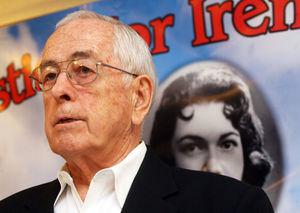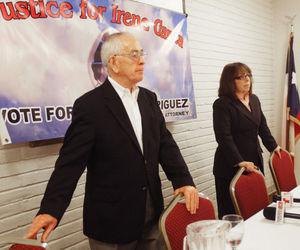|
Former priest recalls Feit’s confession in Irene Garza case
By Kristian Hernandez
The news that former Sacred Heart priest John Feit was arrested last week in connection to the 1960 homicide of Irene Garza did not come as a surprise to Dale Tacheny. For 52 years, Tacheny has believed Feit, now 83 years old, killed the young Texas beauty queen the night before Easter, because he said he heard about the crime from Feit himself. Tacheny also believed that the pastor of Sacred Heart at the time worked in concert with McAllen police to cover up Feit’s involvement in the murder that was to become perhaps McAllen’s most notorious unsolved crime ever. “He mentioned he had heard the (sacrament of) confession of Irene Garza and after hearing her confession he assaulted her, bound her, and gagged her,” Tacheny told The Monitor last week. “He removed her clothing from the waist up and fondled her.” Tacheny, now 86 years old, recalled Feit’s words Wednesday afternoon from his office in Oklahoma City, where he works as a tax preparer. Since 2002, Tacheny has repeated the story of Feit’s confession to police and the media. Barring any new evidence that a Hidalgo County grand jury might have heard when it indicted Feit two weeks ago, Tacheny could emerge as a key prosecution witness in Feit’s case, which now centers in Arizona, where Feit was arrested and where he has announced his intent to fight extradition to Texas. “Father Feit told me that at another location than the priest house, where he had heard her confession, he put her in a bathtub and put a bag of some sort over her head and, as he was leaving, she was saying, ‘I cannot breathe, I can’t breathe,’ and when he returned, Irene was dead,” Tacheny said. Garza’s body was found floating in an irrigation canal on April 21, 1960. Investigators suspected Feit in her death after police later found a portable projector belonging to Feit inside the Second Street canal near where Garza’s body had been found. According to investigators, Garza, a 25-year-old schoolteacher, had gone to Sacred Heart Church in McAllen, where she had planned to attend confession during Holy Week and was never seen alive again. Despite an intense police investigation after Garza’s death, no arrests were ever made until last week. McAllen police and the Texas Rangers renewed their focus on the case in 2002. And in a strange coincidence, it was also a time in which Tacheny, after keeping secret Feit’s confession for decades, decided to break his silence and reached out to San Antonio police, where Feit had once lived. The lead Texas Ranger investigator in the Garza case happened to work in San Antonio where Tacheny’s report finally made its way to him. From 1960 to 1967, Tacheny, also known as Father M. Immanuel, was the novice master at a Trappist monastery of Our Lady of Assumption in Ava, Missouri. He was a monk-priest and remembers his abbot calling him one day and asking him to help with a Texas priest who needed some help becoming a monk. “I was asked by Bruno Pagant to counsel the priest that had been accused of murder and who in fact had murdered a young woman,” reads a letter Tacheny wrote to authorities on April 25, 2002, a copy of which Tacheny shared with The Monitor. Tacheny said he worked closely with Feit as he determined if the then 28-year-old priest was fit to join the monastery. In 2005, Tacheny told The Monitor that Feit was bothered by women with high heels who walked on hard floors. “’Click, Click, Click,’ that click caused him anxiety,” Tacheny said. “He had at one time accosted a woman at a church, and there were tendencies that were unhealthy, and I felt it was important to see if we could have some type of behavior modification where Feit would not be compelled to do something like that.” In March of 1960, about three weeks before Garza’s murder, Feit was accused of assaulting Maria America Guerra, 20, inside the sanctuary of Sacred Heart Church in Edinburg, according to court documents. After a mistrial in that case, Feit pleaded no contest to misdemeanor charges of aggravated assault in 1962 and was issued a $500 fine, court documents show. After spending less than a year in the monastery, Feit decided he wanted to leave, which worried Father Joseph O’Brien, the pastor at Sacred Heart in McAllen, who had sent Feit there in 1963. Tacheny said he later learned O’Brien had made arrangements then with law enforcement in McAllen not to arrest Feit after he was also linked to the murder of Irene Garza. “He said the church would take care of Father Feit if it was found that he was the one that killed Irene Garza,” Tacheny said. During his time at the monastery, Feit confided in Tacheny details about the murder. Tacheny said he never repeated these details to anyone for 39 years. In 2002, Tacheny said he was approached by Father Robert J. Brousseau to participate in an autobiographical book titled “A Dying Breed of Brave Men.” “I said to Bob Brousseau, ‘I can’t do this prior to letting law enforcement know,’” Tacheny said. “I probably should have done it sooner, but that’s not the way I saw things in 1962.” In an attempt to clear his conscience, Tacheny called police in San Antonio where he believed Feit had killed a young woman during Holy Week. “At that time I had no name. At that time I knew it was a young woman roughly 23 years old. At that time I was not sure where she was killed. At that time I did not know about the canal in which her body was placed,” Tacheny said. San Antonio police Det. George Saider spoke to Tacheny about the Holy Week murder and asked Tacheny to write a letter stating what he knew. “She went to confession to the priest, because of certain phobias she was unable to go into the confessional box. Thus the priest took her to the Parish house to hear her confession.” reads the 2002 letter. “After hearing her confession he assaulted her, and gagged her.” In the letter Tacheny also assured Detective Saider that the information he is stating is information Feit gave him was during counseling sessions and does not fall under the confessional seal. Months passed before the phone rang one autumn day in Tacheny’s office. On the other end was Saider, who told him there was a possible link to a case in McAllen. Texas Ranger Rudy Jaramillo, the lead investigator in Garza’s case, contacted Tacheny and asked him to meet him in San Antonio. After their meeting, both of them agreed they had been investigating the same case. “Once I found out it was McAllen and found out who the people that were injured as a result of that, I made up my mind that I was going to go down there and apologize for not coming forward sooner,” Tacheny said. In 2004, Tacheny met with two of Irene Garza’s cousins, Noemi Sigler and Lynda de La Viña. He also met with O’Brien, who was initially upset about him coming forward about Feit. “When he first saw me he said, ‘Damn you Tacheny, why did you tell them?’” Tacheny recalls. “I had no sense of a need to protect Father Feit whatsoever — that was not my responsibility. It had nothing to do with the church.” O’Brien later told investigators what he knew about Feit, Tacheny said. O’Brien died in 2005. “I was told by the abbot to perform this particular function in relation to Father Feit and I was doing something I was told to do,” Tacheny said. “You don’t know what the atmosphere was at that time in monasteries. You obeyed what your abbot told you to do as long as it was lucid.” In 2002, when Garza’s case was reopened, Feit, who had been living in Phoenix, was called by an investigator who asked him if there was anything he could tell them as someone who had seen Garza just before she was murdered. “That man doesn’t exist anymore,” Feit replied, according to a Dallas Morning News article published Nov. 20, 2004. “If he is not the same guy today as the person back then, then he will give no problem in extradition,” Tacheny said, citing the article. “Second, he will plead guilty before the trial. Then he will prove he is not today the same person who did what he did to Irene Garza, that’s the only way he will prove it.” “Fighting extradition is saying, ‘I’m guilty.’ Basically, he doesn’t want it to happen,” Tacheny said. Feit is expected to plead not guilty as he fights extradition. Contact: khernandez@themonitor.com
|
.
Any original material on these pages is copyright © BishopAccountability.org 2004. Reproduce freely with attribution.

